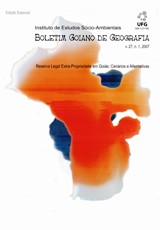SISTEMA DE RESERVA LEGAL EXTRA-PROPRIEDADE EM GOIÁS: ANÁLISE DE CUSTO E BENEFÍCIOS ECONÔMICOS E AMBIENTAIS À ESCALA DA PAISAGEM - DOI 10.5216/bgg.v27i1.3440
DOI:
https://doi.org/10.5216/bgg.v27i1.3440Keywords:
gestão territorial, SEUC, reserva legalAbstract
Aproximadamente 47% do bioma Cerrado, um dos hotspots de biodiversidade no mundo, já foram desmatados. Em Goiás, único Estado da federação totalmente inserido nos limites do bioma, em torno de 63% da vegetação original já foram transformados em áreas de pastagens e agricultura. Infelizmente, muito deste desmatamento, ainda em curso, tem se dado à revelia do Código Florestal, ao mesmo tempo em que as áreas sob proteção integral correspondem apenas a 1% do território goiano. Nestas circunstâncias, o uso de instrumentos econômicos, entre eles o sistema de reserva legal extra-propriedade, pode vir a ser um importante mecanismo com vistas à proteção da cobertura vegetal e aglomeração dos fragmentos remanescentes. Assim, neste artigo discutimos vários aspectos pertinentes à simulação dos mercados de reserva legal em Goiás, em particular àqueles voltados às escalas e abrangência das análises, bem como os vários tipos de cenários regulatórios e espaciais, no âmbito dos quais as transações podem ocorrer. Por fim, e tendo por referência o Sistema Estadual de Unidades de Conservação (SEUC), apresentamos um conjunto de ações e estratégias voltadas à: a) consolidação e expansão do SEUC, b) definição de mecanismos legais para a implementação dos mercados de cotas de reserva florestal e c) desenvolvimento de um sistema de gestão territorial e ambiental para Goiás.
Downloads
Downloads
Published
How to Cite
Issue
Section
License
Authors will not receive any payment for publishing their work in Boletim Goiano de Geografia. Therefore, they must grant all rights to the journal. However, they are entirely and exclusively responsible for the published contents, and editors are free to make corrections or adjustments to texts in conformity with publication guidelines.







